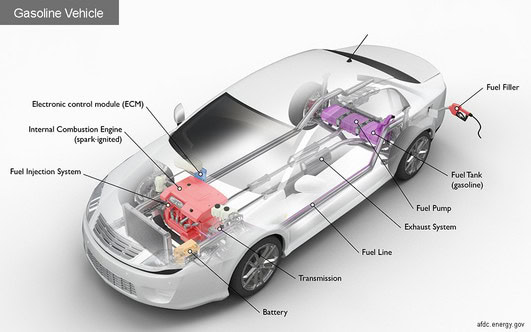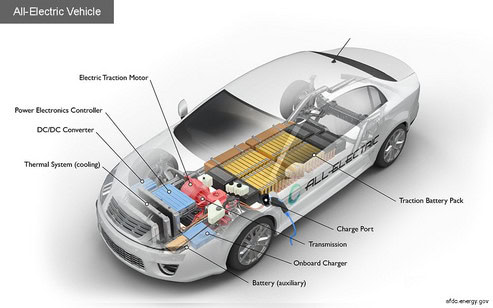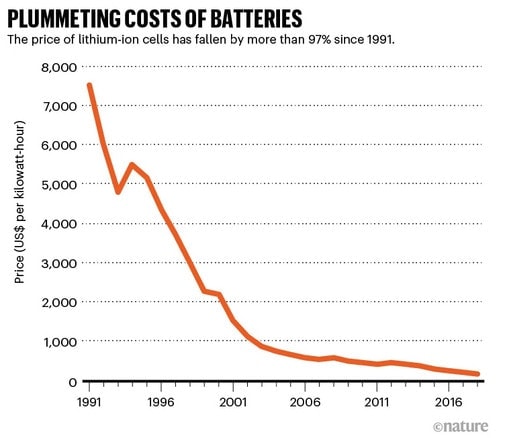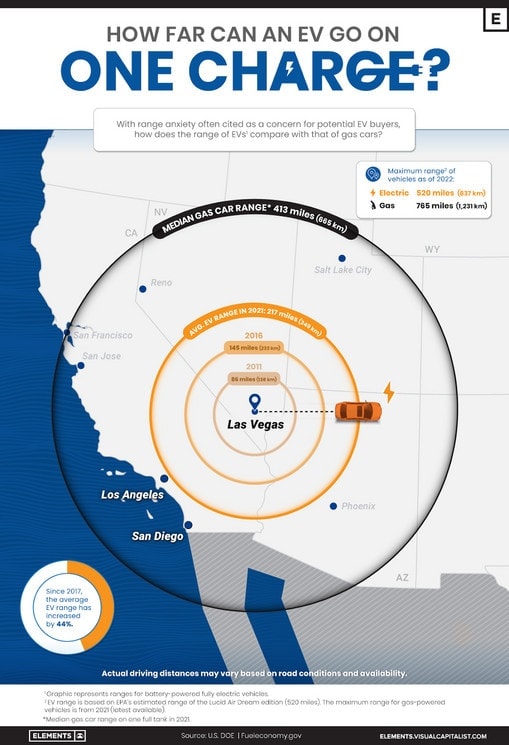
Electric cars are starting to become part of our everyday lives. More and more people are investing in this ‘green’ option as developments in infrastructure make electric cars a practical and more sustainable alternative to gasoline.
But with these developments, people have started to doubt whether they are, in fact, better for the environment. Ultimately, the answer is yes, they are.
However, when assessing EVs’ (electric vehicles) sustainability, there is plenty to consider. In this article, we look at how electric cars work, the battery manufacturing process, the charging process, and technological advances to help explain why they are a better alternative to gasoline cars for the environment.
Key Takeaways: - EV batteries can be stripped down to reuse the raw materials. Around 80% of the components are recyclable. - By 2025, recycled cobalt is expected to cover 40% of EV battery demand. - On average, using an EV will save you $1,000 a year because of the low price of electricity compared to gas. - EVs emit no tailpipe emissions.
How Do Electric Cars Work?
It’s easier to have a visual aid and a comparison to understand how EVs work. So, first, we’ll briefly look at the mechanics of a gasoline car.

Image Source: Energy.gov
The most important element of this car to consider is the Internal Combustion Engine (ICE). This engine works with a four-part process: intake, compression, combustion and power stroke, and exhaust.
The exhaust is where ICEs become a problem. The waste gasses produced during combustion are released into the atmosphere from the tailpipe. These include carbon dioxide, carbon monoxide, and nitrogen oxides, which are harmful to the environment and people breathing them in.
So How Do EVs Avoid Exhaust Fumes?
Below is a diagram of a standard all-electric vehicle. You can see it doesn’t have an exhaust system because EVs do not emit harmful gasses when driving. This is because the ICE has been replaced with a battery.

Image Source: Energy.gov
This battery is like any other. It needs to plug into an outlet to charge. The electricity stored in the traction battery pack is used by the electric traction motor, which drives the wheels. It does this through the transmission, which transfers mechanical power from the electric traction motor to the wheels.
This means that EVs need no fuel and therefore have zero tailpipe emissions. So why wouldn’t they be better for the environment? The main contentious issue with these vehicles doesn’t focus on emissions. Instead, the manufacturing process of the battery is being called into question. So let’s take a deeper look.
Is Battery Manufacturing Bad for the Environment?
To explore this question, let’s break down the manufacturing process into easy-to-understand steps.
- Batteries are made from ‘raw materials’ that include base and precious metals. Precious metals that are needed, like graphite and lithium, are very expensive and difficult to mine.
- Mining these can be controversial. It can cause environmental, political, and humanitarian problems. Almost 500,000 gallons of water are needed to extract one ton of lithium. This can cause big issues for agriculture and can cost a lot of money. A lot of these metals can only be found in specific areas of the world, leading to political issues.
- These elements make up the positive and negative electrodes, which, when combined with electrolytes, produce an electric current.

Image Source: Nature.com
So, it’s clear that the manufacturing process needs a lot of initial energy, which can cause worldwide issues. Now we need to compare this with the energy gasoline cars use.
How Does This Compare With Gasoline Cars?
The ICCT states: “Electric vehicle manufacturing requires more energy and produces more emissions than manufacturing a conventional car because of the electric vehicles’ batteries. Lithium-ion battery production requires extracting and refining rare earth metals and is energy intensive because of the high heat and sterile conditions involved.”
However, take a look at the graph below from the Environmental Protection Agency:

Image Source: Epa.gov
It’s clear from this bar chart that despite the manufacturing process using more energy, in the long run, EVs produce a lot less greenhouse gas emissions than gasoline cars and are therefore better for the environment.
As for the disposal of the battery:
- They can be stripped down to reuse the raw materials. Around 80% of the components are recyclable.
- At the end of their life, they can still store at least 70% of their original capacity. This means they can be repurposed for uses like electrical grids for storing electricity from renewable energy sources like wind and solar.
Below is Linklaters’ battery life cycle chart, which shows the range of potential activities for the end of an EV battery’s life.

Image Source: Linklaters.com
That said, this is assuming the batteries are indeed recycled and not just thrown in a landfill. This is a serious concern with the mass production of EVs and needs to have government regulations over how old EVs are disposed of.
What About Electricity Production for Charging the Car?
Charging an electric car can produce greenhouse gasses. However, it depends on how local energy is generated.
Below, you can see the difference between tailpipe and upstream emissions. When considering an EV’s sustainability, the focus should be on upstream emissions.

Image Source: Source
If your area primarily uses coal to generate electricity, then charging your car could be very harmful because of the greenhouse gasses released while burning the coal.
Equally, it’s just as likely (if not more) that your local area generates electricity using primarily renewable sources. This means electric vehicles have the potential to be completely emission-free. And the good news is this is looking more likely.
In 2020, renewables became the second-most prevalent U.S. electricity source among coal, natural gas, and nuclear. Meaning, if you invest in an electric car, it is likely you will be using sustainable energy sources to charge it.

Image Source: Eia.gov
If you want to be sure, check the amount of greenhouse gas emissions associated with driving an electric car in your area by entering your zip code here: https://www.fueleconomy.gov/feg/Find.do?action=bt2
Related Reading: Where does the electricity come from for electric cars?
Advances in Electric Car Production
So, it’s becoming clear that electric cars are already a great and greener option for transport. And the good news is, it’s only getting better:
- Reusing and Recycling batteries is a growing market. By 2025, recycled cobalt is expected to cover 40% of EV battery demand.
- There is constant ongoing research into making the manufacturing process more energy efficient and sustainable. Battery makers are investing heavily in creating cheaper, denser and lighter batteries.
- Changes in legislation surrounding car emissions are encouraging people to opt for EVs. Low-emission zones are very common in Europe, especially in the UK, and the first LEZ is being piloted in California. London’s ULEZ (ultra-low emission zone) has already seen a 44% drop in NO2 concentration in the air.
EVs are a growing industry, and many investors recognize this. The growth in money and investment leads to more research and developments, meaning the electric car industry will only become more sustainable and accessible for more people.
The Practicality of Owning an Electric Car
So why hasn’t everyone got an electric car? The practicalities of owning an EV are slightly tricky, although this is improving.
Most electric cars have a range of 250-300 miles before they need recharging. There are currently 56,000 EV charging points across the U.S., which is enough to sustain the current number of EVs on the road, but this would need to increase dramatically as EV sales have increased by 40% every year since 2016.

Image Source: Visualcapitalist.com
There’s a lot to know about charging an EV, but here are a few essentials:
- From a home outlet (level 1 charger), it takes about 40 hours to charge an EV fully.
- Level 2 chargers can charge an EV fully overnight or during the workday, which is a popular option among owners.
- Level 3 chargers are often found in public infrastructure, like gas stations. These can fully charge your vehicle in 20-40 minutes. However, it costs more.
- It costs around $1,000-$1,200 to install a home charger.
- Cost of electricity differs depending on the model of the car, the charging outlet, and the source of electricity. On average, a level 3 charging point (most premium) will cost $10-$30 for a full charge.
- On average, using an EV will save you $1,000 a year because of the low price of electricity compared to gas.
For some people, maybe living in a city or a built-up area, an EV looks like a great option. However, it’s not suitable for everyone’s lifestyle. Let’s take a look at the pros and cons.
| Pros of Owning an EV | Cons of Owning an EV |
| Saves you money in gas. | The initial investment is unaffordable for many people. |
| There are plenty of charging points across the US, so you’re unlikely to run out of charge. | If you live in a rural area, there may not be sufficient charging points nearby. |
| There are incentive programs to encourage people to switch to EVs, which might mean you could receive tax credits. | A 300-mile limit is inconvenient for many lifestyles, like traveling a lot for work or pleasure. |
| They are much less polluting, so your carbon footprint would decrease. |
As you can see, whether you should own an EV is largely down to personal lifestyle. It may be the perfect option for some people, but it simply won’t work for others. However, this is likely to change as technology advances.
The range is likely to increase, and infrastructure will continue to improve, making it a more practical option. The price will also likely decrease as competition drives costs down and research uncovers cheaper manufacturing processes.
Are There Any Alternatives?
There is an alternative currently being produced. These are hydrogen-powered cars, or fuel cell electric vehicles. They are powered by a reaction between hydrogen and oxygen, which emits no harmful tailpipe emissions.

Image Source: Energy.gov
This type of vehicle is an interesting alternative to electricity because it only takes 4 minutes to refuel, and its average range is over 300 miles. This eliminates a lot of the practical issues of EVs.
However, despite hydrogen being readily available in the atmosphere, it’s very expensive to make it suitable to power a car. The charging infrastructure is also inadequate at the moment, with less than 400 FCEV stations worldwide.
Despite this, some companies are working on producing their own FCEV, and a few already have. Take a look at Toyota’s Mirai, and Hyundai’s Nexo. So it’s worth keeping an eye on.
Conclusion
It’s clear that electric cars are a better option for the environment. Swapping gasoline for electricity will have a huge impact on reducing our carbon emissions and slowing the progression of the climate crisis.
This isn’t to say EVs are completely clean. There are issues surrounding the manufacturing process, but hopefully, as more research is conducted, it should only improve.
If you can, an EV is a great investment for the planet. If you’re not in the position to do so now, watch this space. They’ll become the new normal soon.